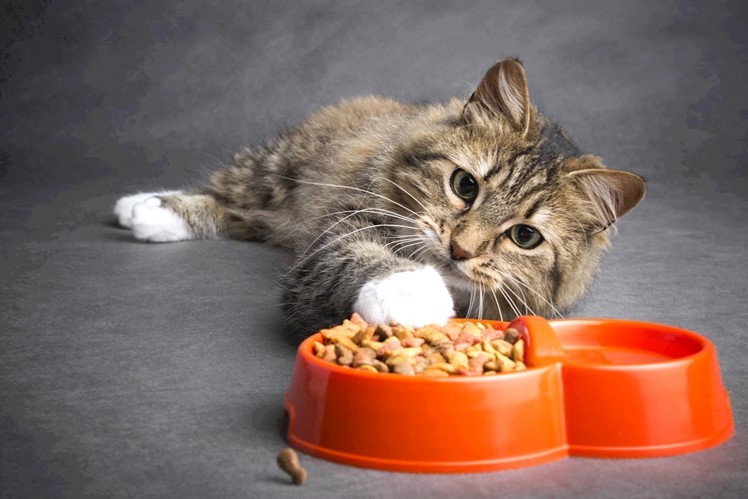Help, my cat won't eat! Read our 7 tips here
We all know it, picky cats are the rule rather than the exception. Most cats turn their noses up at almost anything you put in front of them. It can sometimes be quite a challenge to find suitable food for your little house tiger and get it to eat. In this blog we give you some tips on how to make sure your cat starts feasting (again) on its food.

IMPORTANT: If your cat really doesn't want to eat, this can result in serious health problems (fatty liver). Make sure your cat eats something every day and never let it fast; if your cat has not eaten anything for more than 24 hours, contact your veterinarian.
Oorzaken waarom jouw kat niet eet
If your cat normally just eats its food bowl empty, but suddenly abandons it, there may be illness or pain. So keep a close eye on your little house tiger to see if he or she is eating anything. Also pay close attention if your cat has any of the following symptoms: drowsiness, fever, excessive urination or vomiting; these symptoms may indicate illness.
Another cause of not wanting to eat may be stress. Check that there have been no major changes in the house. Consider a new housemate, moving the eating area or a new object in the house. To minimize the chance of stress, it is important to introduce major changes slowly. Let your house tiger get used to changes slowly.
Lastly, your cat may simply exhibit fussy behavior. This is unfortunately more common in cats than we care for, and finding good food can be challenging.
Tip 1: Keep the food bowl clean
Cats are not only incredibly picky, they are also extremely hygienic. They don't like it when their litter box or food bowl is dirty. When your cat is fed from a food bowl that is not clean, the animal may simply refuse to eat. For example, when bacteria remain in the food bowl, they eventually start to smell. Cats naturally avoid food that is rotten or no longer smells fresh. Therefore, they will also always avoid a food bowl that smells rotten. So make sure the food bowl is always clean.
Tip 2: Change feeding bowls
Not only is it important to keep the food bowl clean, the size of the bowl also plays a role in whether or not your pet will eat. If you have purchased a food bowl that is too small for your cat, his whiskers may touch the rim while eating. Many cats find this very annoying and may avoid the food for this reason. See what happens if you serve your cat food in a larger bowl or in a bowl with a low rim. Perhaps now your cat will want to eat if its whiskers no longer touch the rim.
Tip 3: Wet or heat the food
Another tip is to wet your cat's kibble with warm water. This way the kibble will smell stronger, this often encourages eating faster. When you give wet food to your cat you can heat it slightly. This will also make the food smell stronger.
Tip 4: Change the taste
If your cat really refuses to eat, try a different flavor. Sometimes a cat simply gets tired of a particular flavor. Switching protein sources can then encourage it to eat again.
In doing so, be sure to transition your cat to the new flavor gradually.
Tip 5: Change the diet, but gradually
If your cat still doesn't want to eat after changing the flavor, it could be that he doesn't like the food of the brand he is currently getting (anymore). In that case you can choose to switch to another brand. When you want to switch your cat to another brand of food, do this gradually. Cats sometimes have difficulty getting used to new food. For these animals, taste, smell and texture are very important. When you switch to a different food all at once, your little house tiger may turn its nose up at the food. Moreover, a sudden switch can result in gastrointestinal problems. Therefore, switch gradually over a period of about 9 days. This way you give your cat time to get used to a new smell, taste and texture.
Note: You can only switch gradually when you switch from one kibble to another kibble. When you want to switch from fresh meat or a pressed kibble to a crunchy kibble, though, it's best to switch all at once.
Extra tip: With an XL Trial Pack, you can gradually switch your cat to delicious and healthy Riverwood cat food in a more economical way.
Tip 6: Add some extras
This tip is best saved for last. In fact, once you try this, chances are your cat won't want anything else! Look for a canned food or another ingredient, such as the water from a can of tuna or sardines, that your little house tiger really likes. Add a little bit of this food or ingredient to your cat's kibble. Et voilà, chances are the animal will now eat its bowl nicely.
In this case, a liquid or canned food works best. You can mix this in with the kibble. When you add a dry ingredient to the kibble, your cat can still fish out the tastiest thing and leave the kibble....
Riverwood Caviar for Cats wet foods are ideal as a complementary food to your cat's kibble. These wet foods for cats contain as much as 51% tuna fillet and are also topped with a delicious topping. We're sure your purring house tiger will feast on these!
Tip 7: Schedule a visit to the veterinarian
Sometimes a medical problem can be the cause of your cat's behavior. If the animal is not feeling well, the urge to eat is not there. In addition, a cat may suffer from dental problems. This causes pain while eating so a cat will ignore its food. Do you suspect a medical cause is causing your cat to ignore its food? Schedule a visit to the vet to rule out any medical problems.
After reading these 7 tips, you'll know what to do. Start by assessing the food bowl, if you find nothing wrong with it, try heating the current food or giving your cat a different flavor of food. If this is still no success, then your cat may be fed up with its current food and we recommend you try other food.
Many cats already enjoy Riverwood every day. Would you like your cat to enjoy our delicious kibble and are you curious which variety would suit your cat best? Answer a few questions here and order an inexpensive trial pack.




